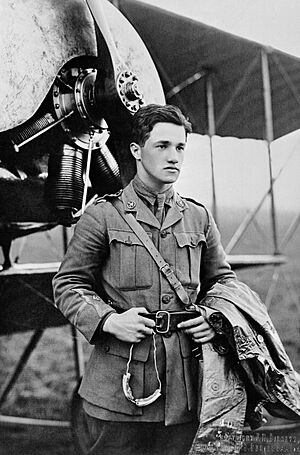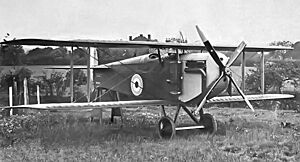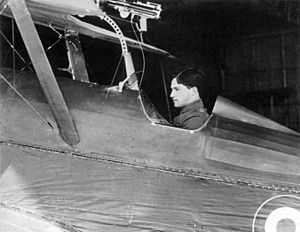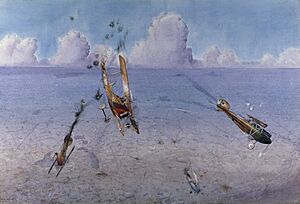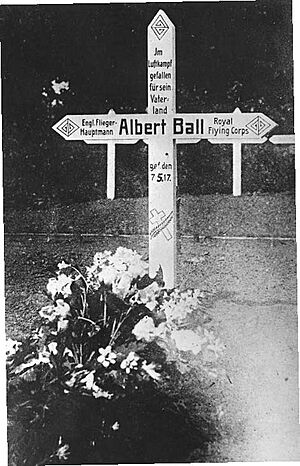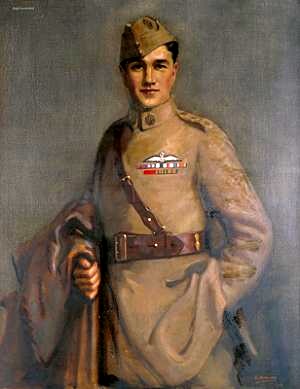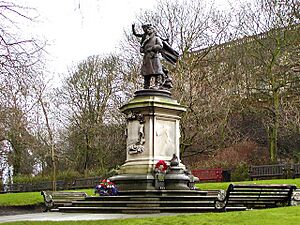Albert Ball facts for kids
Quick facts for kids
Albert Ball
|
|
|---|---|
 |
|
| Born | 14 August 1896 Nottingham, England |
| Died | 7 May 1917 (aged 20) Annœullin, France |
| Buried |
Grave 643, Annœullin Communal Cemetery, German Extension
|
| Allegiance | United Kingdom |
| Service/ |
British Army (1914–15) Royal Flying Corps (1915–17) |
| Years of service | 1914–17 |
| Rank | Captain |
| Unit | Sherwood Foresters (1914–15) North Midlands Cyclist Company (1915) No. 9 Squadron RFC (1915–16) No. 13 Squadron RFC (1916) No. 11 Squadron RFC (1916, twice) No. 8 Squadron RFC (1916) No. 60 Squadron RFC (1916) No. 34 Squadron RFC (1916–17) No. 56 Squadron RFC (1917) |
| Battles/wars |
|
| Awards | Victoria Cross Distinguished Service Order & Two Bars Military Cross Légion d'honneur (France) Order of St. George (Russia) |
| Relations | Sir Albert Ball (father) |
Albert Ball, VC, DSO & Two Bars, MC (born August 14, 1896 – died May 7, 1917) was a brave British fighter pilot during the First World War. When he died, he was the top British flying ace, with 44 victories. He is still remembered as one of the highest-scoring British pilots ever.
Born and raised in Nottingham, England, Albert joined the Sherwood Foresters when the war began in 1914. He became a second lieutenant in October 1914. The next year, he joined the Royal Flying Corps (RFC) and earned his pilot's wings in January 1916. He flew reconnaissance missions in France before joining a fighter unit, No. 11 Squadron, in May. He quickly became famous for his many aerial victories, earning two Distinguished Service Orders and the Military Cross. He was the first British flying ace to become a national hero.
After some time in England, Ball returned to the Western Front in April 1917 with No. 56 Squadron. He died in a plane crash in France on May 7, 1917. His death caused great sadness across the country. He was later awarded the Victoria Cross, Britain's highest award for bravery, for his actions during his last missions. Even the famous German flying ace Manfred von Richthofen (the "Red Baron") said Albert Ball was "by far the best English flying man."
Contents
Albert Ball's Early Life
Albert Ball was born on August 14, 1896, in Lenton, Nottingham. His family moved a few times before settling at a house called Sedgley. His father, Albert Ball, was a successful businessman who became the Lord Mayor of Nottingham and was later knighted. His mother was Harriett Mary Page. Albert had a brother and a sister, and his parents were very loving.
As a boy, Albert loved to tinker with engines and electrical things in a small shed behind his house. He was also very good with firearms and practiced shooting targets in his garden. He had excellent eyesight and became a great shot. Albert was also very religious. Despite this, he was very daring. On his 16th birthday, he climbed a tall factory chimney with a workman and walked around at the top without fear!
Albert went to Lenton Church School, The King's School, Grantham, and Nottingham High School. He then went to Trent College when he was 14. He was an average student but loved learning about machines. His favorite subjects were carpentry, making models, playing the violin, and photography. He was also part of the Officers' Training Corps. After leaving school at 17, his father helped him get a job at an engineering company.
Albert Ball in the First World War
Joining the Army
When the First World War started in August 1914, Albert Ball joined the British Army. He became part of the Sherwood Foresters. He was quickly promoted to sergeant and then to second lieutenant in October. He was assigned to train new soldiers, but he really wanted to be in the action. To get closer to the fighting, he joined the North Midlands Cyclist Company in 1915, but he was still stationed in England. He wrote to his parents, "It is just my luck to be unable to go."
In June 1915, Albert decided to take flying lessons. He paid for private pilot training at the Ruffy-Baumann School. This allowed him to follow his interest in engineering and hoped to get to France faster. He would wake up at 3:00 AM to ride his motorcycle for flying practice before starting his military duties at 6:45 AM.
Becoming a Pilot
Albert's instructors thought he was an average pilot. But he earned his Royal Aero Club pilot's certificate in October 1915. He immediately asked to join the Royal Flying Corps (RFC). He trained at Mousehold Heath near Norwich. He completed his training and earned his pilot's wings in January 1916. A week later, he officially became a pilot in the RFC.
In February 1916, Ball joined No. 13 Squadron RFC in France. He flew two-seat Royal Aircraft Factory B.E.2c planes on reconnaissance missions, which means scouting enemy areas. He survived being shot down by anti-aircraft fire in March. He also had his first air combat in a B.E.2. He wrote home, "I like this job, but nerves do not last long, and you soon want a rest." He also told his father not to let his younger brother join the RFC because it was too dangerous.
Albert's skills and brave attitude helped him get to fly the squadron's single-seat Bristol Scout fighter. He also started thinking about designing a "most wonderful machine" that would be better than the German planes.
First Fighter Missions
In May 1916, Ball moved to No. 11 Squadron, a fighter unit. They flew different types of planes, including Bristol Scouts and Nieuport 16s. He was tired after his first day of flying with his new unit. He didn't like his living quarters and chose to live in a tent near the planes. He later built his own hut and grew a garden.
Albert was mostly a "lone wolf" pilot. He would fly alone, sneaking up on enemy planes from below. He used a special machine gun on his top wing that could fire upwards into the enemy's plane. This was very difficult to do while also flying the plane. He was also a loner on the ground, preferring to stay in his hut away from others. He spent his free time in his garden or playing the violin. He was shy and sensitive. Albert often worked on his own plane, so he was sometimes messy. He also flew without a helmet or goggles and kept his hair longer than allowed.
On May 16, 1916, flying a Bristol Scout, Albert got his first aerial victory. He then switched to Nieuports and shot down two more planes in May and a Fokker Eindecker in June. On June 25, he became a flying ace (meaning he had five or more victories) by destroying an observation balloon. He wrote to his parents, telling them to "take it well" if he was killed, because "men tons better than I go in hundreds every day." He got two more victories on July 2, bringing his total to seven.
Albert then asked for time off but was sent to No. 8 Squadron for reconnaissance duty. He flew B.E.2s from July to August. During this time, he flew a French spy behind enemy lines. He avoided three German fighters and anti-aircraft fire, but the spy refused to leave the plane. While on this duty, he was awarded the Military Cross for his "conspicuous skill and gallantry." He often attacked enemy planes no matter how many there were. He didn't hate his enemies, writing, "I only scrap because it is my duty... Nothing makes me feel more rotten than to see them go down, but you see it is either them or me, so I must do my duty best to make it a case of them."
On his 20th birthday, Albert was promoted to temporary captain and returned to No. 11 Squadron. He destroyed three German planes in one mission on August 22, 1916. This was the first time an RFC pilot had done this. He ended the day fighting 14 German planes far behind their lines. His plane was badly damaged and out of fuel, but he managed to fly it back to Allied lines. He then moved to No. 60 Squadron RFC. His new commander let him fly solo missions and gave him his own plane and crew. One mechanic painted a red propeller boss on his plane, which helped others identify his aircraft and confirm his victories. By the end of August, he had 17 victories.
Albert then went on leave to England. His brave actions in France had made him very famous. He was the first British ace to become a household name. People would stop him in the streets of Nottingham to congratulate him. The British government had previously kept the names of aces secret, but after many losses in the Battle of the Somme, they decided to share news of air successes. Albert's achievements inspired other pilots, including Mick Mannock, who would become Britain's top-scoring ace.
When he returned to No. 60 Squadron, Albert continued to score victories. On September 15, he used special Le Prieur rockets on his plane to break up a German formation. He then shot down one of the pilots. He later flew an improved plane, a Nieuport 17, which he modified to make it easier to reload his machine gun. He also carried a Colt automatic pistol in the cockpit. In September, he had three days where he scored three victories each day. By the end of the month, he had 31 victories, making him Britain's top ace. He told his commander he needed a rest because his nerves were getting bad. On October 3, he was sent on leave to England.
Hero at Home
Albert Ball received the Distinguished Service Order (DSO) and a bar (meaning a second award) on September 26, 1916. The first award was for his "conspicuous gallantry and skill" in fighting two enemy groups. The bar was for attacking four enemy planes and, on another occasion, 12 enemy planes. He also received the Russian Order of St. George that month. Back in England, he was celebrated as a national hero. Journalists waited at his family's home. He told them he had been shot down six times. On November 18, King George V presented him with his Military Cross and both DSOs at Buckingham Palace. He received a second bar to the DSO on November 25, making him the first person to receive the award three times. Albert was promoted to lieutenant in December 1916.
Instead of returning to combat, Albert was assigned to teach new pilots. He also worked to get a new fighter plane, the Austin-Ball A.F.B.1, built and tested. He hoped to take one to France, but it wasn't finished until after he died. He also test-flew the new Royal Aircraft Factory S.E.5 fighter. At first, he didn't like it, finding it less agile than his Nieuports.
On February 19, 1917, Albert was honored by his hometown and became an Honorary Freeman of Nottingham. He met other pilots, including James McCudden and Billy Bishop, who would also become famous aces. On March 25, he met Flora Young and they became engaged on April 5.
Return to Combat
Albert didn't like being away from the fighting. He pushed to return to combat. He finally got a job as a flight commander with No. 56 Squadron RFC, a very skilled unit. Albert was still Britain's top ace, and some thought his time with No. 56 Squadron was meant to be short, to help train new pilots.
The squadron was equipped with the new S.E.5 plane. Albert still preferred his Nieuport 17 and was allowed to keep it for his solo missions. He would fly the S.E.5 for patrols with the squadron. This special arrangement was approved by General Hugh Trenchard, who later became the first head of the Royal Air Force. No. 56 Squadron moved to the Western Front on April 7, 1917. Albert wrote to his parents, "Cheero, am just about to start the great game again."
Albert had his S.E.5 plane modified. He removed the standard machine gun and added a second Lewis gun to fire downwards through the floor. He also had a slightly larger fuel tank installed.
On April 23, 1917, Albert was ordered to stay over British lines, but he still fought German planes five times in his Nieuport. In his first fight, he shot down a German Albatros. He then flew an S.E.5 and, after fixing a jammed gun, surprised five Albatros fighters, sending one down in flames.
Three days later, on April 26, Albert scored two more victories in his S.E.5. The plane was so damaged it had to be sent for repairs. In May, despite problems with his guns jamming, Albert shot down seven Albatros planes in five days. On May 5, one of his victims almost crashed into him. Oil sprayed from his plane's damaged tank, blinding him for a moment. He managed to fly his S.E.5 home with almost no oil pressure. He was so shaken that it took him a while to calm down after landing.
While his S.E.5 was being repaired, Albert flew his Nieuport again on May 6, destroying another Albatros. This brought his total victories to 44. He continued his lone patrols, but the German pilots were getting better at working together, and his plane was taking more damage. On May 6, Albert visited his friend Billy Bishop. He suggested they attack the Red Baron's squadron at their airfield at dawn. Bishop agreed to the plan for later that month. That night, in his last letter to his father, Albert wrote, "I do get tired of always living to kill, and am really beginning to feel like a murderer. Shall be so pleased when I have finished." This shows how much the war affected him.
Final Flight and Legacy
On the evening of May 7, 1917, near Douai, Albert Ball and 10 other British planes from No. 56 Squadron met German fighters. A long dogfight happened in bad weather, and the planes got separated. Albert was last seen chasing a red Albatros D.III, flown by Lothar von Richthofen, the Red Baron's younger brother. Albert's plane was then seen falling upside-down from a dark thundercloud.
German soldiers on the ground rushed to the crash site. Albert Ball was already dead. They said his plane had no bullet holes, and his body had no bullet wounds. Doctors later said he died from a broken back and crushed chest.
The Germans said Lothar von Richthofen shot down Ball. However, there is doubt about this, as Richthofen claimed a different type of plane. It's possible Albert Ball wasn't shot down but became confused and lost control in the bad weather, a problem that affected other pilots. The British government first listed him as "missing." Later that month, the Germans dropped messages behind Allied lines saying Albert Ball was dead. He had been buried in Annoeullin with full military honors. The Germans put a cross on his grave calling him "the English Richthofen."
News of Albert Ball's death spread worldwide. He was called the "wonder boy of the Flying Corps" and the "Ace of English Aces." On June 7, 1917, he received the Croix de Chevalier, Legion d'Honneur, from France. The next day, he was awarded the Victoria Cross for his "most conspicuous and consistent bravery" from April 25 to May 6, 1917. A memorial service was held for him in Nottingham, with large crowds. Albert was promoted to captain on June 15. His Victoria Cross was given to his parents by King George V on July 22, 1917.
Remembering Albert Ball
After the war, Albert Ball's grave was found behind enemy lines. His father asked for his grave to remain in the Annoeullin Cemetery, even though other British graves were moved. Albert Sr. paid for a special memorial stone at his son's grave. He also bought the French field where Albert died and put up a memorial stone there.
In Nottingham, there is a monument and statue of Albert Ball at Nottingham Castle. It was paid for by public donations and shows a life-size statue of Ball with a female figure. It was unveiled in 1921 with military honors. The bronze model of the statue is now in the National Portrait Gallery in London.
Albert Ball's father also built the Albert Ball Memorial Homes in Lenton to house families of local soldiers killed in the war. The Lenton War Memorial, which includes Albert's name, was also paid for by his family. These homes are now protected as historic buildings.
There are other memorials to Albert Ball in Nottingham, including at Holy Trinity Church. In 1967, the Albert Ball VC Scholarships were created at his old school, Trent College. A propeller from one of his planes and the original cross from his grave are displayed there. One of the houses at Nottingham High's Junior School is also named after him.
In 2006, Albert Ball was featured on a special Royal Mail stamp set honoring Victoria Cross recipients. In 2015, he was on a £5 coin as part of a set for the First World War Centenary. His Victoria Cross and other medals are displayed at the Nottingham Castle Museum.
Images for kids
-
Statue of Captain Albert Ball in the grounds of Nottingham Castle
See also
 In Spanish: Albert Ball para niños
In Spanish: Albert Ball para niños


